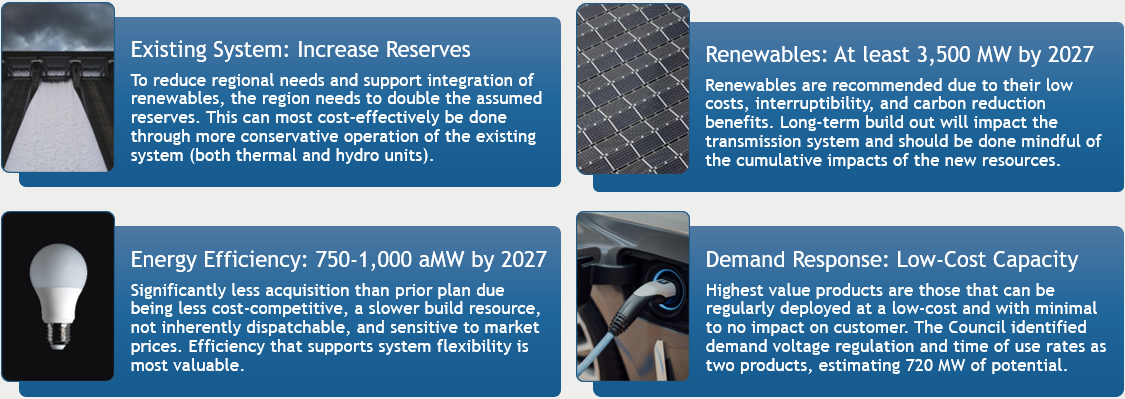Summary
Updated September 2024
The Council’s 2021 Power Plan provided a broad strategy for resource development to ensure an adequate, efficient, economical, and reliable power supply. This includes at least 3,500 MW of renewable development, a range of cost-effective energy efficiency, targeted low-cost and readily deployable demand response, and increasing regional reserves. Since the release of the 2021 Power Plan, the Council has been monitoring changes in the power system, tracking new resource development, and conducted annual assessments of resource adequacy to provide updated information to the region in advance of its next power plan.
The Council recently released its Adequacy Assessment for 2029 (August 2024). This accounts for the rapid changes the grid is experiencing, such as announced coal-to-gas conversions, anticipated load growth, and transmission expansion in the region. The assessment finds that implementing the resource strategy in the plan – specifically achieving energy efficiency consistent with the high end of the Council’s target, pursuing renewable deployment of around 6,600 MW by 2029, and ensuring sufficient balancing resources and demand response – will provide for an adequate system. Areas of risk remain, however. The same strategy, but only pursuing the low end of the Council’s energy efficiency target, would not provide for an adequate system. Further, if data center load growth accelerates and more closely aligns with utility projections in the region by 2029, the resource strategy will also be insufficient to maintain adequacy.
As shown in the dashboard on the right, the Council sees significant progress towards implementing the resource strategy in the 2021 Power Plan. The region has already developed around 90 percent of the minimum renewable build called for by the power plan and is well on pace to develop renewables beyond those assumed in the adequacy assessment. The region and Bonneville are also on pace to achieve the cost-effective efficiency identified in the plan, with data showing the region tracking towards the high end of the Council’s target. Utilities in the region are demonstrating, developing, and running demand response programs that meet their local needs. However, the Council continues to see more potential in demand response products that would support the region’s need for flexibility.
This resource acquisition should be evaluated in concert with the region’s strategy for operational reserves. Not holding sufficient reserves poses risks to resource adequacy. While the long-term picture looks promising, with support from the Western Resource Adequacy Program and a potential day-ahead market (or two), the near-term is more uncertain. The Council found that the most cost-effective way to meet reserves requirements was to be more conservative with the existing system, holding back dispatchable resources and ensuring that they are available if needed. Some entities are operating their systems more conservatively, while others are relying more on the market (or a combination of the two). The 2021 Power Plan identified market reliance as an effective, albeit riskier, method for ensuring sufficient reserves. The 2021 Power Plan also found that additional energy efficiency was an effective, albeit more expensive, way of achieving reserves. With energy efficiency tracking near the high end of the target, and potentially exceeding the target, this might somewhat mitigate the near-term reserves risk.
The Adequacy Assessment for 2029 showed significant adequacy issues with loads increasing, specifically focusing on data center loads. One of the simulated shortfall events in this study had characteristics similar to the winter cold snap that hit the region in January 2024. During the January 2024 event several energy providers experienced record or near-record peaks in power demand, while also navigating a planned outage on a major regional transmission line along with disruptions in both gas and renewable energy supplies without widespread outages. The region relied heavily on out-of-region market purchases at higher prices. This scenario demonstrates the risk that near-term, fast-paced load growth poses to the region without coordinated resource and transmission development. It is important to note that the Council’s resource tracking dashboard (to the right) demonstrating good progress towards 2021 Power Plan goals does not reflect whether there is sufficient resource development in a scenario with this fast-paced load growth from the high-tech industry. The Council will be exploring this, and other risk areas, in its upcoming power plan to provide new guidance to the region in support of a continued adequate, efficient, economical, and reliable power supply.
2021 Power Plan Resource Strategy

The Council’s 2021 Power Plan was developed during a time of rapid change in the power system. Driven by shifting resource economics and clean policies across the region, the Council developed a resource strategy that was more dynamic than in previous power plans. This strategy included recommendations to:
- Acquire between 750 and 1,000 average megawatts of cost-effective energy efficiency
- Acquire at least 3,500 megawatts of renewable energy
- Acquire low-cost and frequently deployable demand response, such as the 720 megawatts of time-of-use and demand voltage regulation potential identified in the plan
- Use the existing system conservatively to provide additional reserves to help integrate new resources (roughly double the assumed existing reserve levels)
The 2021 Power Plan included several recommendations that support this resource strategy.
Annual Adequacy Assessment
The Council conducts annual assessments of resource adequacy. This assessment looks five years out to provide an update on whether the Council’s 2021 Power Plan recommendations continue to provide sufficient direction to the region to ensure an adequate power supply. The Council has developed a new multi-metric approach for adequacy that factors in the frequency, duration, magnitude, and timing of events. Collectively, these metrics will allow the Council to provide more robust direction to the region.
The Council recently released its Adequacy Assessment for 2029. During the development of the annual assessment, the Council also develops these different studies to update assumptions and better reflect the current conditions in the power system. This includes:
- Natural Gas Price Forecast (2023)
- Updated Generating Resource Reference Plants (April 2024)
- Hourly Load Forecast (May 2024)
- Market Price Forecast (August 2024)






